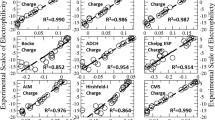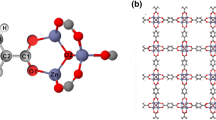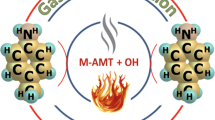Abstract
A series of polynitroprismanes, C6H6−n (NO2) n (n = 1–6) intended for use as high energy density compounds (HEDCs) were designed computationally. Their electronic structures, heats of formation, interactions between nitro groups, specific enthalpies of combustion, bond dissociation energies, and explosive performances (detonation velocities and detonation pressures) were calculated using density functional theory (DFT) with the 6-311 G** basis set. The results showed that all of the polynitroprismanes had high positive heats of formation that increased with the number of substitutions for the prismane derivatives, while the specific enthalpy of combustion decreased as the number of nitro groups increased. In addition, the range of enthalpy of combustion reducing is getting smaller. Interactions between ortho (vicinal) groups deviate from the group additivity rule and decrease as the number of nitro groups increases. In terms of thermodynamic stability, all of the polynitroprismanes had higher bond dissociation energies (BDEs) than RDX and HMX. Detonation velocities and detonation pressures were estimated using modified Kamlet–Jacobs equations based on the heat of detonation (Q) and the theoretical density of the molecule (ρ). It was found that ρ, D, and P are strongly linearly related to the number of nitro groups. Taking both their energetic properties and thermal stabilities into account, pentanitroprismane and hexanitroprismane are potential candidate HEDCs.


Similar content being viewed by others
References
Korkin AA, Bartlett RJ (1996) Theoretical prediction of 2,4,6-trinitro-1,3,5-triazine (TNTA). A new, powerful, high-energy density material? J Am Chem Soc 118:12244–12245
Engelke R (1993) Ab initio calculations of ten carbon/nitrogen cubanoids. J Am Chem Soc 115:2961–2967
Fan XW, Ju XH, Xiao HM (2008) Density functional theory study of piperidine and diazocine compounds. J Hazard Mater 156:342–347
Johnson MA, Truong TN (1999) Importance of polarization in simulations of condensed phase energetic materials. J Phys Chem B 103:9392–9393
Fau S, Bartlett RJ (2001) Possible products of the end-on addition of N −3 to N +5 and their stability. J Phys Chem A 105:4096–4106
Tian A, Ding F, Zhang L, Xie Y, Schaefer HF (1997) New isomers of N8 without double bonds. J Phys Chem A 101:1946–1950
Casey K, Thomas J, Fairman K, Strout DL (2008) Stability and dissociation energies of open-chain N4C2. J Chem Theor Comput 4:1423–1427
Strout DL (2002) Acyclic N10 fails as a high energy density material. J Phys Chem A 106:816–818
Li QS, Zhao JF (2002) Theoretical study of potential energy surfaces for N12 clusters. J Phys Chem A 106:5367–5372
Li QS, Liu YD (2002) Structures and stability of N11 cluster. Chem Phys Lett 353:204–212
Smiglak M, Metlen A, Rogers RD (2007) The second evolution of ionic liquids: from solvents and separations to advanced materials—energetic examples from the ionic liquid cookbook. Acc Chem Res 40:1182–1192
Chavez DE, Hiskey MA, Gilardi RD (2000) 3,3′-Azobis(6-amino-1,2,4,5-tetrazine): a novel high-nitrogen energetic material. Angew Chem Int Ed 39:1791–1793
Marcus HJ, Remanick A (1963) The reaction of hydrazine with 3,6-diamino-s-tetrazine. J Org Chem 28:2372–2375
Singh RP, Verma RD, Meshri DT, Shreeve JM (2006) Energetic nitrogen-rich salts and ionic liquids. Angew Chem Int Ed 45:3584–3601
Miller DR, Swenson DC, Gillan EG (2004) Synthesis and structure of 2,5,8-triazido-s-heptazine: an energetic and luminescent precursor to nitrogen-rich carbon nitrides. J Am Chem Soc 126:5372–5373
Fischer A, Antonietti M, Thomas A (2007) Growth confined by the nitrogen source: synthesis of pure metal nitride nanoparticles in mesoporous graphitic carbon nitride. Adv Mater 19:264–267
Levchik SV, Balabanovich AI, Ivashkevich OA, Lesnikovich AI, Gaponik PN, Costa L (1993) The thermal decomposition of aminotetrazoles. Part 2. 1-Methyl-5-aminotetrazole and 1,5-diaminotetrazole. Thermochim Acta 225:53–65
Lesnikovich AI, Ivashkevich OA, Levchik SV, Balabanovich AI, Gaponik PN, Kulak AA (2002) Thermal decomposition of aminotetrazoles. Thermochim Acta 388:233–251
Ghule VD, Jadhav PM, Patil RS, Radhakrishnan S, Soman T (2009) Quantum-chemical studies on hexaazaisowurtzitanes. J Phys Chem A 114:498–503
Politzer P, Lane P, Murray JS (2011) Computational characterization of a potential energetic compound: 1,3,5,7-tetranitro-2,4,6,8-tetraazacubane. Central Eur J Energ Mater 8:39–52
Gan LH (2006) Theoretical investigation of polyhedral hydrocarbons (CH) n . Chem Phys Lett 421:305–308
Xu WG, Liu XF, Lu SX (2009) Theoretical investigation on the heats of formation and the interactions among the isocyano groups in polyisocyanoprismanes C6H6−n (NC) n (n = 1–6). J Hazard Mater 162:1317–1321
Xu WG, Liu XF, Lu SX (2008) Theoretical investigation on the heats of formation and the interactions among the azido groups in polyazidoprismanes C6H6−n (N3) n (n = 1–6). J Mol Struct THEOCHEM 864:80–84
Politzer P, Seminario JM (1989) Computational determination of the structures and some properties of tetrahedrane, prismane, and some of their aza analogs. J Phys Chem 93:588–592
Politzer P, Seminario JM (1990) Relative bond strengths in tetrahedrane, prismane, and some of their aza analogs. Struct Chem 1:29–32
Liu Y, Gong XD, Wang LJ, Wang GX, Xiao HM (2011) Substituent effects on the properties related to detonation performance and sensitivity for 2,2′,4,4′,6,6′-hexanitroazobenzene derivatives. J Phys Chem A 115:1754–1762
Lee C, Yang W, Parr RG (1988) Development of the Colle–Salvetti correlation-energy formula into a functional of the electron density. Phys Rev B 37:785–789
Woon DE, Dunning JTH (1993) Gaussian basis sets for use in correlated molecular calculations. III. The atoms aluminum through argon. J Chem Phys 98:1358–1371
Chen PC, Chieh YC, Tzeng SC (2003) Density functional calculations of the heats of formation for various aromatic nitro compounds. J Mol Struct THEOCHEM 634:215–224
Chen ZX, Xiao JM, Xiao HM, Chiu YN (1999) Studies on heats of formation for tetrazole derivatives with density functional theory B3LYP method. J Phys Chem A 103:8062–8066
Owens FJ (1996) Calculation of energy barriers for bond rupture in some energetic molecules. J Mol Struct THEOCHEM 370:11–168
Xu XJ, Xiao HM, Gong XD, Ju XH, Chen ZX (2005) Theoretical studies on the vibrational spectra, thermodynamic properties, detonation properties, and pyrolysis mechanisms for polynitroadamantanes. J Phys Chem A 109:11268–11274
Xu XJ, Xiao HM, Ma XF, Ju XH (2006) Looking for high-energy density compounds among hexaazaadamantane derivatives with CN, NC, and ONO2 groups. Int J Quantum Chem 106:1561–1568
Rice BM, Hare JJ, Byrd EFC (2007) Accurate predictions of crystal densities using quantum mechanical molecular volumes. J Phys Chem A 111:10874–10879
Qiu L, Xiao HM, Gong XD, Ju XH, Zhu WH (2007) Crystal density predictions for nitramines based on quantum chemistry. J Hazard Mater 141:280–288
Jinshan L (2010) A quantitative relationship for the shock sensitivities of energetic compounds based on X–NO2 (X = C, N, O) bond dissociation energy. J Hazard Mater 180:768–772
Rice BM, Sahu S, Owens FJ (2002) Density functional calculations of bond dissociation energies for NO2 scission in some nitroaromatic molecules. J Mol Struct THEOCHEM 583:69–72
Fan JF, Xiao HM (1996) Theoretical study on pyrolysis and sensitivity of energetic compounds. (2) Nitro derivatives of benzene. J Mol Struct THEOCHEM 365:225–229
Brill TB, James KJ (1993) Kinetics and mechanisms of thermal decomposition of nitroaromatic explosives. Chem Rev 93:2667–2692
Wang GX, Gong XD, Liu Y, Du HC, Xu XJ, Xiao HM (2010) A theoretical investigation on the structures, densities, detonation properties and pyrolysis mechanism of the nitro derivatives of toluenes. J Hazard Mater 177:703–710
Zhang JJ, Xiao HM (2002) Computational studies on the infrared vibrational spectra, thermodynamic properties, detonation properties, and pyrolysis mechanism of octanitrocubane. J Chem Phys 116:10674–10683
Fan XW, Ju XH (2008) Theoretical studies on four-membered ring compounds with NF2, ONO2, N3, and NO2 groups. J Comput Chem 29:505–513
Xu XJ, Xiao HM, Ju XH, Gong XD, Zhu WH (2006) Computational studies on polynitrohexaazaadmantanes as potential high energy density materials. J Phys Chem A 110:5929–5933
Murray JS, Concha MC, Politzer P (2009) Links between surface electrostatic potentials of energetic molecules, impact sensitivities and C–NO2, N–NO2 bond dissociation energies. Mol Phys 107:89–97
Chung G, Schmidt MW, Gordon MS (2000) An ab initio study of potential energy surfaces for N8 isomers. J Phys Chem A 104:5647–5650
Wei T, Zhu WH, Zhang JJ, Xiao HM (2010) DFT study on energetic tetrazolo-[1,5-b]-1,2,4,5-tetrazine and 1,2,4-triazolo-[4,3-b]-1,2,4,5-tetrazine derivatives. J Hazard Mater 179:581–590
Politzer P, Ma Y, Lane P, Concha MC (2005) Computational prediction of standard gas, liquid, and solid-phase heats of formation and heats of vaporization and sublimation. Int J Quantum Chem 105:341–347
Wang F, Du HC, Zhang JY, Gong XD (2011) Comparative theoretical studies of energetic azo s-triazines. J Phys Chem A 115:11852–11860
Wei T, Zhu WH, Zhang XW, Li YF, Xiao HM (2009) Molecular design of 1,2,4,5-tetrazine-based high-energy density materials. J Phys Chem A 113:9404–9412
Talawar MB, Sivabalan R, Mukundan T, Muthurajan H, Sikder AK, Gandhe BR, Rao AS (2009) Environmentally compatible next generation green energetic materials (GEMs). J Hazard Mater 161(2–3):589–607
Acknowledgments
This work is supported by the Natural Science Foundation of Shanxi Province (no. 2010021009-2), the Natural Science Foundation of China (no. 20871077), a research project supported by the Shanxi Scholarship Council of China (no. 201063), and the Natural Science Foundation of Shanxi Normal University.
Author information
Authors and Affiliations
Corresponding author
Rights and permissions
About this article
Cite this article
Chi, WJ., Li, LL., Li, BT. et al. Density functional calculations for a high energy density compound of formula C6H6−n (NO2) n . J Mol Model 18, 3695–3704 (2012). https://doi.org/10.1007/s00894-012-1367-6
Received:
Accepted:
Published:
Issue Date:
DOI: https://doi.org/10.1007/s00894-012-1367-6




